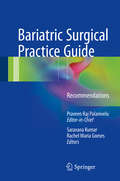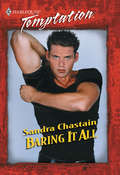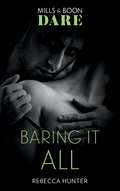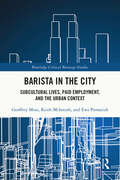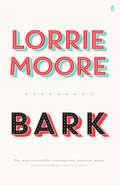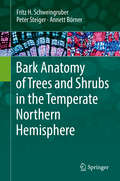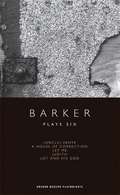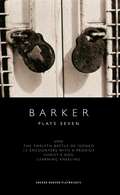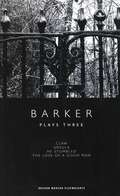- Table View
- List View
Bariatric Surgery: A Guide for Mental Health Professionals
by James E. Mitchell Martina De ZwaanThis book provides mental health professionals with a basic overview of the types of procedures involved in bariatric surgery and the specific psychological impacts such operations can have on their patients. It also serves as a valuable resource to surgeons, nurses, doctors, and support staff who are involved in the medical treatment of obesity, but who may have little background in the psychosocial implications of their work. An accompanying questionnaire is available at http://www.eatingdisordersarena.com/resources/EDQ.pdf
Bariatric Surgery: A Guide for Mental Health Professionals
by James E. Mitchell Martina De ZwaanThis book provides mental health professionals with a basic overview of the types of procedures involved in bariatric surgery and the specific psychological impacts such operations can have on their patients. It also serves as a valuable resource to surgeons, nurses, doctors, and support staff who are involved in the medical treatment of obesity, but who may have little background in the psychosocial implications of their work. An accompanying questionnaire is available at http://www.eatingdisordersarena.com/resources/EDQ.pdf
Bariatric Surgery Complications: The Medical Practitioner’s Essential Guide
by Robin P. BlackstoneThis text provides a background of scientific evidence to understand the complications that occur after bariatric surgery for all providers responsible for care after surgical intervention. Written by experts and based on current peer reviewed literature, the text provides a focused approach to the identification and treatment of bariatric surgery complications. To establish a context for providers, the initial section concentrates on presenting the current procedures as well as risks and expected benefits of each with an emphasis on mechanism of action. It examines the issue of weight regain from the aspect of heterogeneity in order to present the perspective that every procedure has risk of weight regain. The text provides guidance to those front line providers who manage acute emergencies and chronic long term problems. State of the art management of complications like leaks, bleeding, ulcers, blood clots and pneumonia are discussed for all procedures in addition to the management of rapid remission of obesity related disease like Type 2 Diabetes and coagulopathies (Leiden Factor V, Protein C and S) that occur commonly in patients with obesity. Each chapter features a review of the current literature in an easy to reference table format and where appropriate an algorithm to focus the reader on the process of care for any given presenting sign or symptom.Bariatric Surgery Complications will be of great value to fellows in minimally invasive surgery, general surgeons, emergency room physicians, gastroenterologists, primary care physicians, medical students and residents in surgery rotations, integrated health personnel.
Bariatric Surgery Complications and Emergencies
by Daniel M. HerronThis book provides a concise, focused and clinically relevant summary of complications and emergencies related to bariatric surgery. The first section of the text addresses general complications related to anesthesia and the stress of surgery, including issues such as deep vein thrombosis, pulmonary embolism, hemorrhage, pneumonia and cardiac complications. Additionally, this section addresses the workup of the bariatric patient with abdominal pain. The second portion of the text focuses on gastric bypass and sleeve-specific complications, including staple line and anastomotic leaks, internal hernia, marginal ulceration, GI obstruction, hernia formation and gallstone disease. The third portion of the book examines metabolic, nutritional and psychological complications after bariatric surgery. The text also covers management of weight loss failure. Bariatric Surgery Complications and Emergencies serves as a very useful resource for physicians and surgeons who are involved in any parts of evaluation or management of bariatric patients suffering from postoperative complications or emergencies including bariatric surgeons who perform these operations on a regular basis, non-bariatric general surgeons who cover such patients when on-call, surgical trainees, and primary care physicians.
Bariatric Surgery in Clinical Practice (In Clinical Practice)
by David Haslam Aseem Malhotra Matthew S. CapehornThe book is needed for several reasons. Bariatric surgery is one of the most clinically effective and cost effective services in any field of medicine, and is growing in popularity, and the non-specialist family practitioner, allied health professional and pharmacist need to know exactly what it involves. Bariatric surgery is in everyone’s interest – whether medic or patient, as it offers improvement in diabetes, heart disease, sleep apnoea, fatty liver and many cancers, whilst reducing benefits, housing costs and the general burden on the economy. There is a lot of flawed thinking on surgery in primary care, with only a minority of family practitioner specialists making the majority of referrals, whilst many are denying their patients access because of their own misconceived ideas. A ‘back to basics’ book will help tackle the negative views surrounding the topic, and improve the volume and quality of referrals. Very often patients turning up to obesity centres have been given poor advice, and inappropriate treatment, and arrive with little or no idea what to expect. Many medics prioritise other conditions first, overlooking the underlying cause, i.e. obesity. Basic education on obesity and co-morbidities is fast becoming essential.
Bariatric Surgery Patients: A Nutritional Guide
by Betty Wedman-St Louis"Approximately 65% of our population is overweight and 12% are morbidly obese. This is despite more than 25 years of attempted medical management. Clearly all current efforts have failed to control this enormous problem. Could it be that we have failed to recognize the cause of the disease and therefore have misdirected our efforts?" — Alfredo Fernandez, MD, FASMBS, Surgeon, Tampa, Florida Reducing obesity through bariatric surgery provides a sustainable weight loss regimen, because it restricts the size of the stomach and limits food intake. However, the surgery limits the amount of nutrients absorbed by the stomach and small intestine. This book provides a comprehensive, practical guide on pre- and post-nutrition considerations in bariatric patients. It describes surgeries including gastric bypass, lap band, and sleeve; nutrition protocols for surgery patients; pregnancy considerations- pre- and post-surgery; food consumption post-surgery; advancing healthy food intake after surgery; minimizing negative side effects; and recommendations to maintain healthy diet. This nutritional guide provides health care practitioners descriptions and answers to the many questions bariatric surgery patients need to know and ask in support group meetings and individual counseling sessions. The first chapter focuses on Selling Obesity and Food as a Cheap and Legal Drug, outlining how food advertising, portion size increases, and food frauds have contributed to the obesity crisis. New research into gut hormones, microbiome influence on obesity, firmicutes, and histamine are included, as well as pregnancy after bariatric surgery and lifestyle changes—eating, sleep, hydration, stress management—needed for success after surgery. Many health care practitioners will use the Post Op Discharge Diet stages of progression to explain how the patient needs to prepare for their liquid diet and overcome numerous issues like dumping syndrome, hypoglycemia, and alcohol and caffeine consumption. Diet plans for Ketogenic, Mediterranean DASH, Glycemic, and Low FODMAP are included within this book.
Bariatric Surgery Patients: A Nutritional Guide
by Betty Wedman-St Louis"Approximately 65% of our population is overweight and 12% are morbidly obese. This is despite more than 25 years of attempted medical management. Clearly all current efforts have failed to control this enormous problem. Could it be that we have failed to recognize the cause of the disease and therefore have misdirected our efforts?" — Alfredo Fernandez, MD, FASMBS, Surgeon, Tampa, Florida Reducing obesity through bariatric surgery provides a sustainable weight loss regimen, because it restricts the size of the stomach and limits food intake. However, the surgery limits the amount of nutrients absorbed by the stomach and small intestine. This book provides a comprehensive, practical guide on pre- and post-nutrition considerations in bariatric patients. It describes surgeries including gastric bypass, lap band, and sleeve; nutrition protocols for surgery patients; pregnancy considerations- pre- and post-surgery; food consumption post-surgery; advancing healthy food intake after surgery; minimizing negative side effects; and recommendations to maintain healthy diet. This nutritional guide provides health care practitioners descriptions and answers to the many questions bariatric surgery patients need to know and ask in support group meetings and individual counseling sessions. The first chapter focuses on Selling Obesity and Food as a Cheap and Legal Drug, outlining how food advertising, portion size increases, and food frauds have contributed to the obesity crisis. New research into gut hormones, microbiome influence on obesity, firmicutes, and histamine are included, as well as pregnancy after bariatric surgery and lifestyle changes—eating, sleep, hydration, stress management—needed for success after surgery. Many health care practitioners will use the Post Op Discharge Diet stages of progression to explain how the patient needs to prepare for their liquid diet and overcome numerous issues like dumping syndrome, hypoglycemia, and alcohol and caffeine consumption. Diet plans for Ketogenic, Mediterranean DASH, Glycemic, and Low FODMAP are included within this book.
Bariatric Surgical Practice Guide: Recommendations
by Praveen Raj Palanivelu Saravana Kumar Rachel Maria GomesThis book provides a comprehensive review of literature of various aspects of bariatric surgery arriving at practical recommendations for simplifying day to day practice. This book is divided into 10 sections covering selection of patient, preoperative predictors of outcome, technical considerations, specific situations, post-operative pathways, management of complications, revisional surgery, and perioperative nutritional aspects. It covers specific situations in bariatric surgery such as GERD, hernia repair, gallstone disease, PCOD, NAFLD and end-organ disease.Bariatric Surgical Practice Guide is a quick resource for practicing bariatric surgeons, young and experienced, to understand all practical aspects of this surgery which is gaining importance worldwide at a rapid pace. Recommendations are based on existing literature as well as opinions of the authors who work at state-of-the-art clinical facilities.
Bariatric Therapy: Alliance Between Gastroenterologists And Surgeons
by Jérôme Dargent Elisabeth M.H. Mathus-VliegenThis book aims to deepen collaboration between gastroenterologists and surgeons by providing endoscopists and gastroenterologists with a clear understanding of the anatomic alterations likely to be observed after bariatric surgery and acquainting bariatric surgeons with the possibilities offered by endoscopic treatment of obesity itself and of the complications associated with bariatric surgery. The treatment approach in patients with obesity and morbid obesity is usually stepwise, starting with dietary measures, exercise, and behavioral therapy, followed by pharmaceutical therapies, endoscopic bariatric therapy, and, finally, bariatric surgery. Endoscopists and gastroenterologists are involved first because the gastrointestinal tract is affected by obesity-related co-morbidity and second because it provides access for a range of treatment modalities involving endoscopy. Bariatric surgeons may need the assistance of endoscopists and gastroenterologists in the preoperative work-up of patients, in the perioperative period, when acute complications may require an endoscopic intervention, or in the late follow-up period, when complications or insufficient weight loss may be present. This book will be of value for both groups of specialists, enabling them to optimize their cooperation to the benefit of patients.
Barile’s Clinical Toxicology: Principles and Mechanisms
by Frank A. BarileExamines the complex interactions associated with clinical toxicological events as a result of therapeutic drug administration or chemical exposure. Special emphasis is placed on signs and symptoms of diseases and pathology caused by toxins and clinical drugs. Includes the source, pharmacological and toxicological mechanism of action, detection and identification in body fluids, and treatment of exposure. An overview of protocols for managing various toxic ingestions, and the antidotes and treatments associated with their pathology, are discussed. In addition, effect of toxins on a limited number of body systems and drug-induced adverse drug reactions are also covered. Key Features Examines the complex interactions associated with clinical toxicological events Emphasis is placed on signs and symptoms of diseases and pathology caused by toxins and clinical drugs Discusses source of the drug or chemical, pharmacological and toxicological mechanisms of action, detection, identification, and treatment Covers effect of toxins on body systems and drug-induced adverse reactions
Barile’s Clinical Toxicology: Principles and Mechanisms
by Frank A. BarileAs with the two previous editions, Barile’s Clinical Toxicology: Principles and Mechanisms, Third edition, examines the complex interactions associated with clinical toxicological events as a result of therapeutic drug administration or chemical exposure. With special emphasis placed on signs and symptoms of diseases and pathology caused by toxins and clinical drugs, the new edition, examines the complex interactions associated with clinical toxicological events as a result of therapeutic drug administration or chemical exposure. The new edition presents the latest, up-to-date protocols for managing various toxic ingestions, and the antidotes and treatments associated with their pathology. In addition, the effect of toxins on a limited number of body systems and drug-induced adverse drug reactions are also covered. KEY FEATURES • Discusses source of the drug or chemical, pharmacological and toxicological mechanisms of action, detection, identification, and treatment • Examines the complex interactions associated with clinical toxicological events • Emphasizes the signs and symptoms of diseases and pathology caused by toxins and clinical drugs • Covers effect of toxins on body systems and drug-induced adverse reactions • Offers a unique perspective for toxicology, pharmacology, pharmacy and health professions students The target audience for this book is undergraduate and graduate toxicology students, clinical pharmacy (Pharm.D.) students, emergency medical personnel, regulatory agencies, and other related health science professionals. It satisfies an essential need for a concise yet detailed authoritative, fundamental text addressing the current principles of clinical toxicology.
Baring Brothers and the Birth of Modern Finance (Financial History)
by Peter E AustinIn 1995, the Baring Brothers collapsed over a weekend, brought down by the 'rogue trader' Nick Leeson. Utilizing British and American archives, this work charts Baring Brothers development from wool merchants to one of the most powerful global financial institutions. It also analyses the errors which led to its downfall.
Baring Brothers and the Birth of Modern Finance (Financial History #3)
by Peter E AustinIn 1995, the Baring Brothers collapsed over a weekend, brought down by the 'rogue trader' Nick Leeson. Utilizing British and American archives, this work charts Baring Brothers development from wool merchants to one of the most powerful global financial institutions. It also analyses the errors which led to its downfall.
Baring It All: (sweet Talkin' Guys) (Mills And Boon Temptation Ser. #No. 768)
by Sandra ChastainAs his alter ego, Lord Sin, Ryan amassed a fortune by making women want him. But now that he's ready to put his past behind him, he can't keep his hands off the one woman determined to destroy him.
Baring It All: Mr Temptation / Baring It All (blackmore, Inc. ) (Blackmore, Inc. #3)
by Rebecca Hunter“Let me see you strip…” First their clothes—then their inhibitions..
Barista in the City: Subcultural Lives, Paid Employment, and the Urban Context (Routledge Critical Beverage Studies)
by Geoffrey Moss Keith McIntosh Ewa ProtasiukBarista in the City examines the impact of paid employment and the contemporary neoliberal context on the subcultural lives of hipsters who are employed as baristas. This book’s analysis of Philadelphia baristas employed within specialty coffee shops suggests that the existing literature on the relationship between neoliberalism and urban subcultures needs to be amended. The subcultural participants discussed within previous studies lived intensely subcultural lives that were ultimately diminished due to processes of gentrification and displacement. The subcultural lives of the baristas investigated by the authors were greatly diminished from the very beginning. Neoliberal policies, and structures of class, race, gender, and gentrification intersected with their employment in ways that diminished their ability to establish lives that constitute a full-fledged subcultural alternative. In its conclusion, the book presents a new theoretical perspective that could aid researchers who study urban subcultures. It also discusses the implications of its analysis for urban policy. This book is an essential update on previous scholarship pertaining to urban subcultures. It also contributes to existing literatures on hipsters, gentrification, and service sector employment within the city. It is suitable for students and scholars in Urban Sociology, Urban Studies, Cultural Studies, and the Sociology of Work.
Barista in the City: Subcultural Lives, Paid Employment, and the Urban Context (Routledge Critical Beverage Studies)
by Geoffrey Moss Keith McIntosh Ewa ProtasiukBarista in the City examines the impact of paid employment and the contemporary neoliberal context on the subcultural lives of hipsters who are employed as baristas. This book’s analysis of Philadelphia baristas employed within specialty coffee shops suggests that the existing literature on the relationship between neoliberalism and urban subcultures needs to be amended. The subcultural participants discussed within previous studies lived intensely subcultural lives that were ultimately diminished due to processes of gentrification and displacement. The subcultural lives of the baristas investigated by the authors were greatly diminished from the very beginning. Neoliberal policies, and structures of class, race, gender, and gentrification intersected with their employment in ways that diminished their ability to establish lives that constitute a full-fledged subcultural alternative. In its conclusion, the book presents a new theoretical perspective that could aid researchers who study urban subcultures. It also discusses the implications of its analysis for urban policy. This book is an essential update on previous scholarship pertaining to urban subcultures. It also contributes to existing literatures on hipsters, gentrification, and service sector employment within the city. It is suitable for students and scholars in Urban Sociology, Urban Studies, Cultural Studies, and the Sociology of Work.
Barite-Fluorite Mineralization in Southeast Sichuan, Yangtze Block, China (Modern Approaches in Solid Earth Sciences #23)
by Hao Zou Shou-Ting Zhang Min Li Zhan-Zhang XuThis book describes the mineralization process of barite-fluorite deposits in southeastern Sichuan, Yangtze Block, China. Mainly through systematic field geological surveys and detailed indoor research work, the typical barite-fluorite deposits in this area were analyzed using a variety of analysis methods such as single fluid inclusion LA-ICP-MS composition analysis, trace rare earth element analysis, H-O-S-Sr isotope analysis, F element content analysis, and Sm-Nd geochronological analysis. By in-depth analysis of the ore-forming environment, mineralization process and geological characteristics of barite-fluorite deposits, the following were determined: (1) the source of ore-forming fluids of barite-fluorite deposits and (2) the migration, concentration, enrichment, and evolution of ore-forming sources, exploring the formation mechanism of barite-fluorite deposits. Summarizing the mineralization regularity of the deposit in this area of China provides a new insight and basis for the study of similar types of deposits in the world.
Bark: Stories (Vintage Contemporaries Ser.)
by Lorrie MooreIn these eight masterful stories, Lorrie Moore, explores the passage of time, and summons up its inevitable sorrows and comic pitfalls.In 'Debarking', a newly divorced man tries to keep his wits about him as the US prepares to invade Iraq. In 'Foes', a political argument goes grotesquely awry as the events of 9/11 unexpectedly manifest at a fundraising dinner in Georgetown. In 'The Juniper Tree', a teacher, visited by the ghost of her recently deceased friend, is forced to sing 'The Star Spangled Banner' in a kind of nightmare reunion. And in 'Wings', we watch the unraveling of two once-hopeful musicians, who neither held fast to their dreams, nor struck out along other paths.Gimlet-eyed social observation, the public and private absurdities of American life, dramatic irony, and enduring half-cracked love wend their way through each of these narratives, in Moore's characteristic style that is always tender, never sentimental and often heartbreakingly funny.
Bark Anatomy of Trees and Shrubs in the Temperate Northern Hemisphere
by Fritz H. Schweingruber Peter Steiger Annett BörnerThis book presents the microscopic and macroscopic bark structure of more than 180 different tree and shrub species from Europe, Asia and North America. It is the first compendium to demonstrate the anatomical variability in bark since almost 70 years (Holdheide 1951). The introductory chapter explains with high-quality microphotographs the anatomical traits most important for identification and ecological interpretation of barks, and the monographic part demonstrates in text and pictures the species-specific patterns. The species treatments are grouped by their main biomes. Each species description first characterizes the macroscopic aspects with its main form, features and habitat with text and pictures of the whole plant and the barks in a young and old stage. This is followed by the microscopical description of each species. The microscopic photographs are based on double-stained slides, revealing the quality and distribution of unlignified and lignified tissues in low and high magnification. The book fills a scientific gap: Archeologists and soil scientists want to identify prehistoric and historical remnants. Ecophysiologists are interested in the distribution of conducting and non-conducting tissues in the phloem and xylem along the stem axis and the internal longevity of cells. Ecologists get information about internal defense mechanisms and technologists are enabled to recognize indicators relevant in biophysics and technology.
Bark and Wood Boring Insects in Living Trees in Europe, a Synthesis
by François Lieutier Andrea Battisti Keith R. Day Hugh F. Evans Jean-Claude GrégoireFor the first time, a synthesis on the research work done in Europe on all Bark And Wood Boring Insects In Living Trees (BAWBILT) is presented. As final product of a four-year research project gathering together 100 scientists from 24 countries, the book is the fruit of a real collective synthesis in which all European specialists have participated. It reviews and comments on all the European literature, while considering the biological (trees, insects, associated organisms, and their relationships) and forest management aspects. However, although focused on the European forest, it also compares the available information and interpretations to those concerning similar species in other continents. It ends with propositions of research priorities for Europe. The book is directed to all scientists and students concerned with forest entomology and ecology, as well as to forest managers and all scientific public interested in forest biology.
Bark / The Silence (Storycuts)
by Julian BarnesIn 'Bark', Jeanne-Etiene Delacour takes pleasure in the avoidance of any threat to his longevity. Formerly a gourmand and a gambler but now an ascetic, his fastidious new lifestyle is the result of an investment in a public works project - one which holds the promise of considerable reward for the last investor to survive. As he draws black lines through the thirty-nine names in his pocket book, the human capacity to rationalise any indulgence is explored.In 'The Silence', a composer attests that silence is the logical conclusion to music. He considers the silence that has been in effect throughout the interminable wait for his Eight Symphony, and how it will segue into the silence that will follow the end of his life - a life he claims to have sacrificed on the altar of his art. Part of the Storycuts series, these two stories were previously published in the collection The Lemon Table.
Barker: Plays Six (Oberon Modern Playwrights)
by Howard BarkerIncludes the plays Judith, (Uncle) Vanya, A House of Correction, Let Me and Lot and His GodBarker’s radical rewriting of Chekhov’s classic (Uncle) Vanya brought him more controversy than most of his other works put together. Interrogating not so much Chekhov’s text as the use to which society has put it, Barker turns Vanya’s defeat into victory and converts a play of sadness into a tragedy of desire. A House of Correction is a meditation on cause and effect. Set on the eve of a war which may destroy a society, the seemingly arbitrary arrival of a messenger with a vital communication sets off an agonizing train of events in the lives of three desperate women.Few works of drama can have plumbed the depths of solitude and rage that characterize Let Me, a nightmare set on the frontiers of the Roman Empire during the barbarian invasions. Biblical narratives serve as the origin of two shorter works, of which Judith is a contemporary classic of cultural conflict, a reinterpretation of the status of the heroine in Israel’s war of survival against the Assyrians. In Lot and His God, the imminent destruction of Sodom simultaneously licenses the moral decay of an angel and the erotic epiphany of an adored wife.
Barker: Plays Seven (Oberon Modern Playwrights)
by Howard BarkerUnd, a play for one woman and six trays, is a moving study of dignityand self-delusion. When a guest, perhaps a lover, fails to appear foran appointment, his hostess invents excuses for his neglect, evenwhen ill-manners degenerate into barbarity. The hostess is Jewish, theinvisible guest a Nazi officer.The Twelfth Battle of Isonzo is the twelfth marriage of a very old manto a young woman a fraction of his age. Their mutual fascination isintensified but also rendered ambiguous by the fact that both are blind.The intellectual and erotic manoeuvres conducted between them areakin to a dance, and what begins as a hypothesis becomes a painfulexposure of the many meanings of intimacy.12 Encounters with a Prodigy concentrates a theme Barker has exploredover many plays – the solitude of the precocious child. Kisster, an adoredorphan, has been taught to exploit the pity of the world for his ownadvantage. From inside his fortified personality, Kisster manipulates ahost of predatory characters, keeping at bay angels and vagrants in hisstruggle to survive.In Christ’s Dog the dying Lazar, arch-seducer and bigamist, treads out ajourney he feels compelled to undertake to reach accommodation withhis past. At every stage of his search, a different version of the untoldstory of Christ’s dog is proposed to him. Lazar understands that hisseemingly worthless life – akin to the mongrel that howls at the foot ofthe cross – is a critical element of human morality.Learning Kneeling is perhaps the most terrible of Barker’s works, a playof apparently unredeemed extremity, relieved by a wit and a scrupulousintensity of thought that renders it a tribute to human persistence andimagination. Sturdee, a legless man of property, finds his home andhis mistress seized by terrorists, the leader of whom, Demonstrator byname and instinct, leads him into a nightmare of ambiguities.
Barker: Plays Three (Oberon Modern Playwrights)
by Howard BarkerIncludes the plays Claw, Ursula, He Stumbled and The Love of a Good ManThe plays in this volume range over twenty years, beginning with Barker's first major work for the stage, Claw, a study of urban discontent and political impotence, developed over three stylistically contrasting acts. Its terrible conclusion marked the debut of a vivid dramatic imagination. In Ursula Barker's engagement with the pains of the past, and his way of reinvigorating ancient arguments reaches a high point in his treatment of the legend of St Ursula and the martyrdom of 11,000 virgins, where the virtues of celibacy and marriage are set against the catastrophic passion of a woman described as a 'perfect liar'. Barker's scrutiny of the body and its complex meanings is never more intense than in He Stumbled, the tragedy of a celebrated anatomist whose last dissection becomes his own. The body as a site of political and personal investment is also at the heart of The Love of a Good Man, an early work set on the empty battlefields of the Great War, where the burial of the dead becomes a pretext for private ambition as well as national grief.





